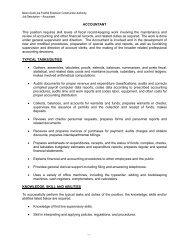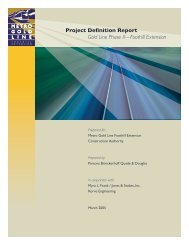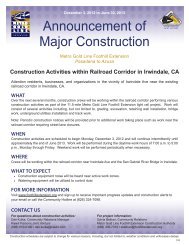Part 3 - Metro Gold Line Foothill Extension
Part 3 - Metro Gold Line Foothill Extension
Part 3 - Metro Gold Line Foothill Extension
Create successful ePaper yourself
Turn your PDF publications into a flip-book with our unique Google optimized e-Paper software.
Noise and Vibration Technical Report: <strong>Metro</strong> <strong>Gold</strong> <strong>Line</strong> <strong>Foothill</strong> <strong>Extension</strong>, Azusa to Montclair<br />
July 2012<br />
Page 93<br />
Figure 33: Typical Vibration Levels<br />
Although there has been relatively little research into human and building response to groundborne<br />
vibration, there is substantial experience with vibration from rail systems. In general, the collective<br />
experience indicates that:<br />
• It is rare that groundborne vibration from transit systems results in building damage, even minor<br />
cosmetic damage. The primary consideration therefore is whether vibration will be intrusive to<br />
building occupants or will interfere with interior activities or machinery.<br />
• The threshold for human perception is approximately 65 VdB. Vibration levels in the range of 70<br />
to 75 VdB are often noticeable but acceptable. Beyond 80 VdB, vibration levels are often<br />
considered unacceptable.<br />
• For human annoyance, there is a relationship between the number of daily events and the degree<br />
of annoyance caused by groundborne vibration. The FTA Guidance Manual includes an 8 VdB<br />
higher impact threshold if there are fewer than 30 events per day and a 3 VdB higher threshold if<br />
there are fewer than 70 events per day.<br />
Often it is necessary to determine the contribution at different frequencies when evaluating vibration or<br />
noise signals. The 1/3-octave band spectrum is the most common procedure used to evaluate frequency<br />
components of acoustic signals. The term “octave” has been borrowed from music where it refers to a<br />
span of eight notes. The ratio of the highest frequency to the lowest frequency in an octave is 2:1. For a<br />
1/3-octave band spectrum, each octave is divided into three bands where the ratio of the lowest frequency<br />
to the highest frequency in each 1/3-octave band is 2 1/3 :1 (1.26:1). An octave consists of three 1/3 octaves.















